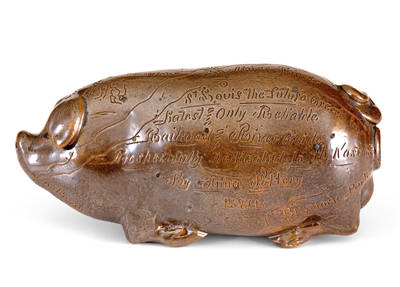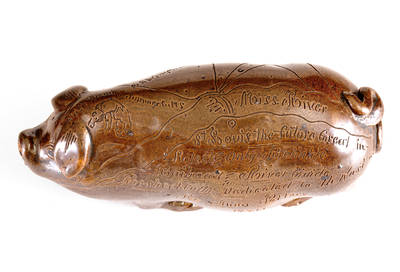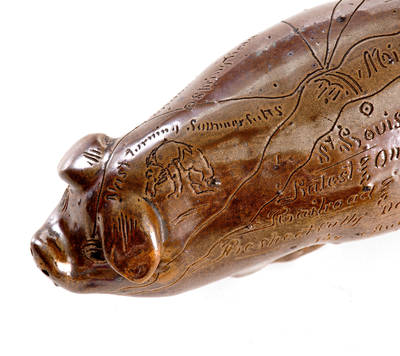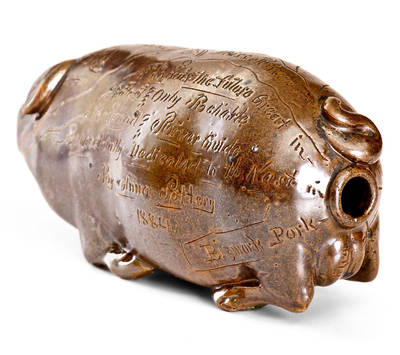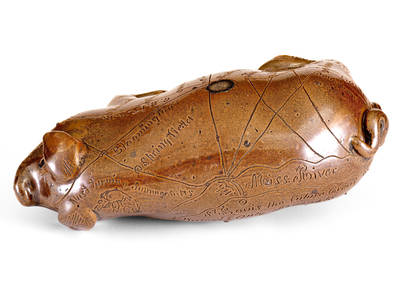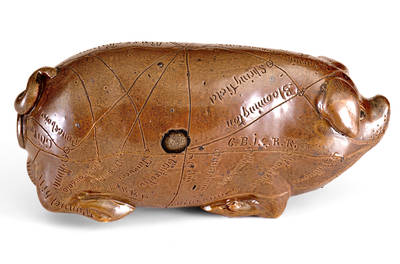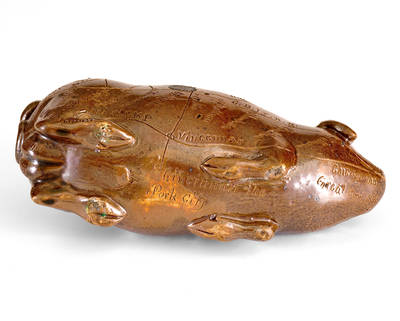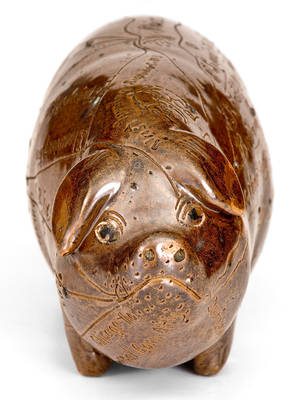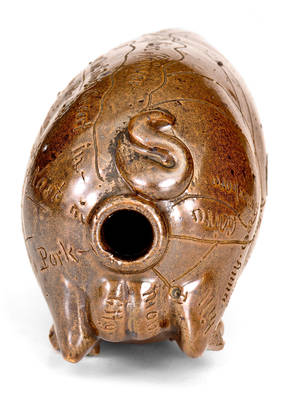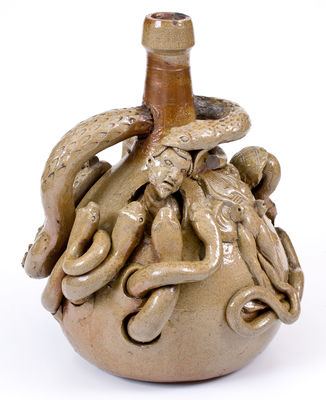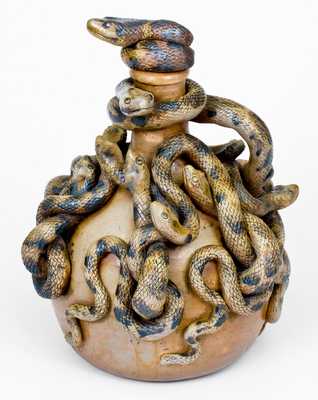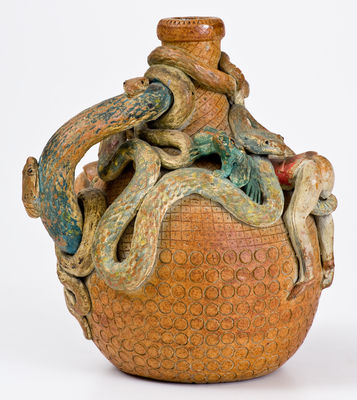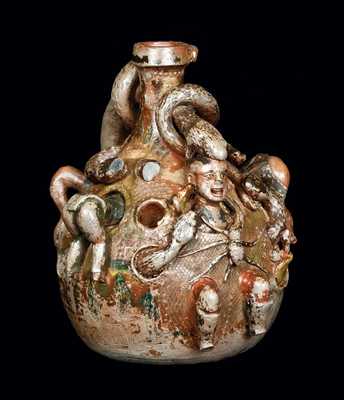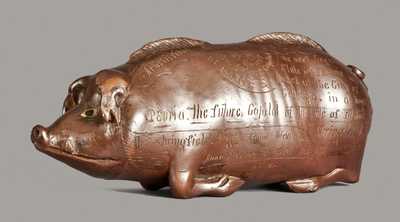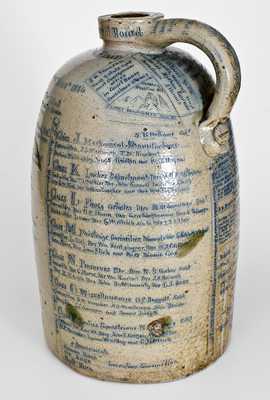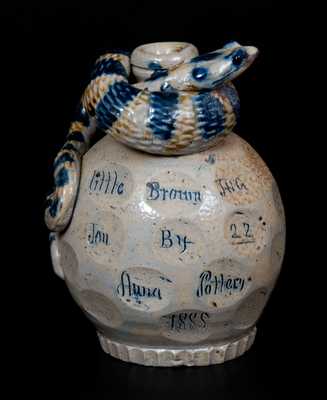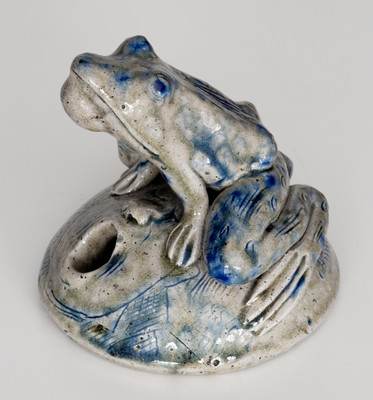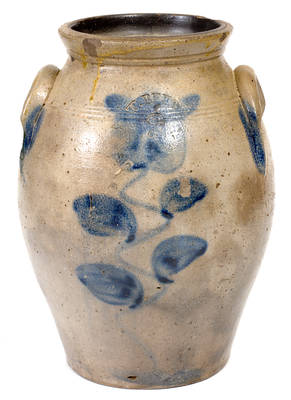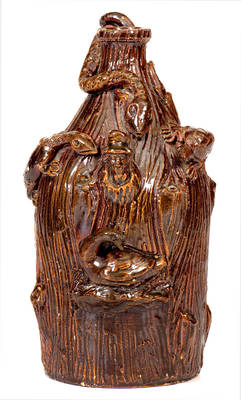Important and Possibly Unique Anna Pottery Stoneware Pig Flask with Dedication to Political Cartoonist, Thomas Nast, Signed "By Anna Pottery / 1884," Wallace and Cornwall Kirkpatrick, Anna, IL, 1884, molded flask in the form of a reclining pig with hole in rear, incised details to face and hooves, and anatomically-correct underside. One side of pig incised with the inscription "Latest and Only Reliable / Railroad and River Guide / Respectfully Dedicated to th Nast in / By Anna Pottery." Additionally incised below within a rectangular border, "Bizmark(sic) Pork-," with the dash pointing to the rear of the pig. The top of this pig features the inscription, "Nast turning summersalts(sic)," with incised image of a man with donkey's head in the act of somersaulting. The remainder of the pig includes an incised railroad map of the Midwestern United States, including the following landmarks: St. Louis the future Great in-, Miss River, Springfield, Bloomington, Jonesboro, Cairo, Anna, Carbondale, Duquoin, Tamaroa, Centralia, Odin, Mattoon, Champaign, Kankakee, Pullman, Vincennes, W st S. & P, Tunnel Hill, Mound City, Dubuque, Cincinnati the Pork City, and Chicago the Great Corn City. Pig includes incised slashes to tops of ears and extremely rare incised stubble on the pig's snout. Surface covered in a metallic brown Albany slip glaze. Original black cold-painted details to eyes. The inscriptions on this pig testify to the Kirkpatrick brothers' intense interest in the renowned Harper's Weekly political cartoonist, Thomas Nast (1840-1902). Many of the Kirkpatricks' finer pieces are political commentaries, often inspired by or referencing this artist's work. On some pieces, the artist himself is even caricatured. Nast, born in Landau, Germany and moving to New York City at age six, is regarded as the "Father of the American Cartoon" and his work is associated with a number of iconic American images. He is credited with creating the modern depiction of Santa Claus and the elephant as the symbol of the Republican Party, as well as popularizing the image of Uncle Sam, the female personification of America known as Columbia, and the donkey as a symbol of the Democratic Party. He worked for Harper's Weekly from 1859 to 1860 and 1862 to 1886, producing 2,250 cartoons over his career. The Kirkpatricks' appreciation for Nast is evidenced by a remarkable stoneware snake jug gifted to the cartoonist in 1871, depicting the heads of members of the Boss Tweed ring on the snakes' bodies. Nast had helped expose the corruption of Tweed's Tammany Hall in his cartoons. The underside of the jug is incised with the presentation inscription, "From, / Kirkpatrick, / Anna Ills / Th. Nast NY." This outstanding work was later gifted by Nast's widow to the New York Historical Society, where it currently resides. The abbreviated name inscription, "Th. Nast," as seen on the bottom of the snake jug and on this pig, is the manner in which Nast signed his autograph, further evidence of the Kirkpatrick's fascination with this artist. While it can be assumed that this pig, like the Boss Tweed snake jug, was gifted to Nast, according to family history, it never left Illinois. The inscription on the back of the pig, "Nast turning summersalts," may indicate that the Kirkpatricks had soured on the man thirteen years after they completed their Boss Tweed snake jug in his honor. The incised slogan likely refers to Nast's decision to support a Democratic Presidential candidate in the Election of 1884, the year this pig was made. Nast, like the Kirkpatricks, had always voted Republican and the Republican candidate had always won. His long career as America's leading political cartoonist had earned him a great deal of influence with the general public. Upon being elected in 1868, Grant declared that he had won "by the sword of Sheridan and pen of Thomas Nast." Several years earlier, while covering the Civil War, Nast had been described by President Lincoln as the Union's best recruiting sergeant and by General Grant as having done as much as any one man to preserve the Union. Therefore, in the Election of 1886, Nast's decision to support Democrat, Grover Cleveland, over Republican candidate, James G. Blaine, was a major political story unto itself. He held that much power in his artwork. Harper's Weekly was displeased with Nast's choice in Cleveland, who ultimately won the presidency, and he was fired in 1886. The Kirkpatricks, as staunch Republicans, were assumedly also upset by Nast's support of Cleveland. The inscription, "Nast turning summersaults," likely refers to Nast's change of political heart, with the cartoonist depicted as a backflipping figure with Democratic donkey's head. This anthropomorphized donkey was likely taken from Nast's cartoons, as he at times caricaturized the Democratic Party as a suited man with donkey's head. As much of the Kirkpatricks' political commentary was meant to be playful, the extent to which the potter-brothers were truly displeased with Nast is unclear here. The inscription at the base of the pig, "Bismarck Pork," is another allusion to Nast's life, referring to German chancellor, Otto von Bismarck (1815-1898), the leader of Nast's home country and an occasional subject of the artist's drawings. This pig is the only example of this iconic Kirkpatrick form that we have seen with a specific dedication to the famed cartoonist that influenced so much of the brothers' work. Including an homage to Nast in the form of its own political cartoon along the pig's back, this outstanding work of American art pottery is among the most important Anna pig flasks known. Provenance: A newly-discovered work, which recently surfaced in the Pacific northwest, having descended in an Illinois family. Excellent, essentially as-made condition. L 6 1/2".

